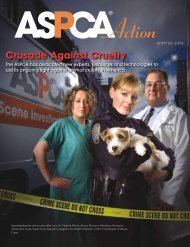ASPCA®Mission:Orange™ ASPCA®Mission:Orange
ASPCA®Mission:Orange™ ASPCA®Mission:Orange
ASPCA®Mission:Orange™ ASPCA®Mission:Orange
You also want an ePaper? Increase the reach of your titles
YUMPU automatically turns print PDFs into web optimized ePapers that Google loves.
PET PARENTS<br />
Spring Cleaning? Keep Your Pets Safe<br />
With the arrival of warmer weather, many pet parents will embark on “do-ityourself”<br />
projects around the home. The ASPCA Animal Poison Control center<br />
offers these helpful hints to keep pets safe.<br />
Paints. Most water-based latex<br />
paints are relatively low in toxicity,<br />
but could still produce stomach<br />
upset. Artist’s paints or other<br />
specialty paints may contain heavy<br />
metals that could potentially be<br />
harmful if large enough amounts<br />
are swallowed. Should your pet get<br />
paint on its skin or hair coat, never<br />
use paint thinner or similar solvents<br />
to remove it—a chemical burn<br />
could result. Instead, use a mild pet<br />
shampoo or liquid hand<br />
dishwashing detergent to bathe the<br />
skin and fur. If paint exposure is<br />
extensive, your<br />
local veterinarian<br />
may need to clip<br />
or shave your pet.<br />
Adhesives &<br />
Glues. Certain<br />
construction<br />
glues may<br />
produce only<br />
mild stomach<br />
upset, while<br />
others can cause<br />
significant<br />
irritation. Some<br />
expanding glue<br />
products can<br />
result in a<br />
potentially lifethreatening<br />
GI<br />
obstruction.<br />
Solvents. Paint<br />
thinners, mineral<br />
spirits, and other<br />
solvents can result in severe<br />
irritation or chemical burns to the<br />
skin, eyes, mouth, and GI tract.<br />
Inhalation could lead to<br />
pneumonia.<br />
Lead. Older homes may contain<br />
lead-based paints. Lead exposures<br />
can occur from eating paint chips<br />
or inhaling paint dust from sanded<br />
surfaces, producing stomach upset<br />
or behavioral or nervous system<br />
problems. Plumbing parts, putty,<br />
rug pads, and linoleum may also<br />
contain lead.<br />
Mold. Mold can be found in<br />
many parts of the home, including<br />
under carpeting, behind walls, or<br />
in heating and cooling ducts, and<br />
can produce stomach upset, heart<br />
problems, or tremors or seizures.<br />
Physical Hazards. Pets could<br />
be at risk from a wide variety of<br />
physical hazards in homes that are<br />
being renovated, including nails,<br />
tacks, staples, screws, insulation,<br />
electrical cords on power tools,<br />
and many others.<br />
Keep pets completely out of areas<br />
where home improvement projects<br />
are occurring, and always read and<br />
follow label directions for safe use<br />
and storage. In certain situations, it<br />
may be advisable to board pets in a<br />
kennel or day-care facility to<br />
eliminate the potential for<br />
exposure to hazardous substances.<br />
If accidental exposure occurs, seek<br />
veterinary assistance promptly by<br />
calling your local veterinarian or<br />
the ASPCA Animal Poison Control<br />
Center (1-888-426-4435, fees may<br />
apply). Have the product container<br />
or packaging available for reference,<br />
as critical ingredient information or<br />
instructions on how to manage<br />
accidental exposures may be on the<br />
label. For more information on<br />
home hazards and keeping your pet<br />
safe, visit the ASPCA Animal<br />
Poison Control Center, on the Web<br />
at: www.apcc.aspca.org.<br />
14 ASPCA Action<br />
www.aspca.org






![Dog Care Tips to Print [PDF] - aspca](https://img.yumpu.com/32104687/1/190x245/dog-care-tips-to-print-pdf-aspca.jpg?quality=85)

![Hiking Safety Tips to Print [PDF] - aspca](https://img.yumpu.com/32018633/1/190x245/hiking-safety-tips-to-print-pdf-aspca.jpg?quality=85)
![Cat Care Tips to Print [PDF] - aspca](https://img.yumpu.com/31952032/1/190x245/cat-care-tips-to-print-pdf-aspca.jpg?quality=85)



